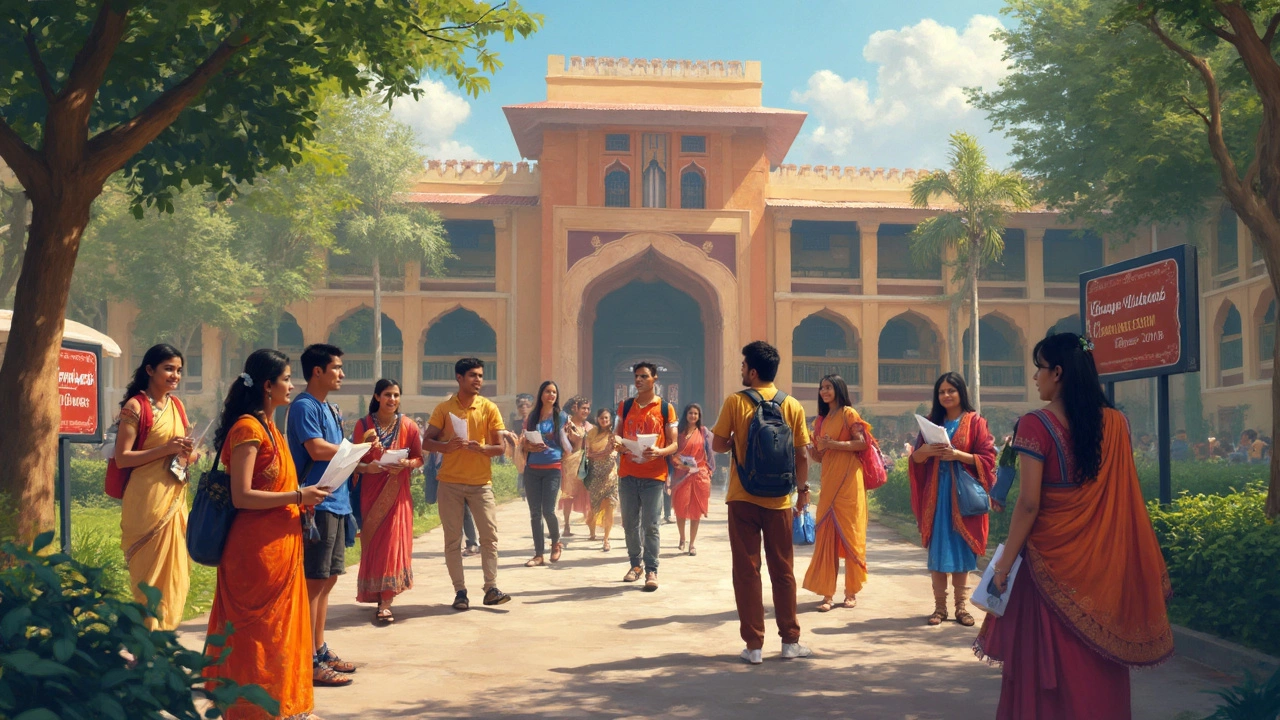If you’re wondering what a diploma really stands for, you’re not alone. Loads of students in India finish their 10th or 12th, eye these quick two- or three-year diploma options, and start thinking—will this get me the same respect as a degree? Will companies treat me the same? Can I get into a government job or move up the ladder later?
Here’s a handy fact: in India, a diploma is usually sandwiched between your school-leaving certificate and a full-fledged degree. For technical fields like engineering, polytechnic diplomas actually pack a punch—people land solid jobs right out of college. But, truth be told, not all diplomas are equal. Some are closer to what you’d call a degree, while others are more like skill-based, short-term courses.
The real catch? The value of your diploma depends not just on the course content, but also on how employers or universities look at it. This can change from one company or government department to another. The rules and perks are not always crystal clear, so it pays to know exactly what your course stacks up to, before betting your future on it.
- How Diplomas Fit into the Indian Education System
- Diploma vs Degree: Key Differences and Similarities
- What a Diploma Can Get You: Jobs, Higher Studies, and More
- Smart Tips to Maximize Your Diploma’s Value
How Diplomas Fit into the Indian Education System
In India, diplomas hold a unique spot in the education ladder. Picture it this way: you’ve got your 10th and 12th standard exams, then you can either go for regular degree courses like BA, BSc, or BCom, or jump into diploma programs. These typically last two to three years and are certified by boards like the State Board of Technical Education or the All India Council for Technical Education (AICTE).
A lot of students head for diplomas right after class 10, especially if they want a quicker route to jobs. Polytechnic diplomas in fields like engineering or computer science are a favorite. For example, after finishing your 10th, you could join a Diploma in Mechanical Engineering, finish in three years, and start earning while your classmates are still slogging through their 12th!
Diving deeper, here’s how diplomas usually slot in:
- diploma equivalent qualifications are seen as one level below a bachelor’s degree and one step above the higher secondary (12th standard).
- After a diploma, you can join the second year of related undergraduate programs. This is called lateral entry – a smooth way to get your degree quicker.
- Other diplomas focus on skills. Nursing, pharmacy, hotel management, fashion design – the list goes on. Colleges run these to help students fast-track into specific careers.
There’s some buzz around how many students prefer these practical diplomas. Government stats actually show that each year, over a million students opt for polytechnic diplomas across the country!
| Stage | Typical Age | Duration | Main Qualification Earned |
|---|---|---|---|
| After 10th | 16+ | 2-3 years | Diploma (e.g. Engineering) |
| After 12th | 17-18+ | 3 years | Bachelor’s Degree |
| Specializations | Varies | 1-2 years | Advanced/Higher Diploma |
If your main goal is to learn hands-on skills and enter the job market sooner, diploma courses in India deliver exactly that. Plus, with a clear pathway to upgrade to degrees later, it’s not a dead-end. You get the best of both worlds: quick career start without shutting the door on more studies down the line.
Diploma vs Degree: Key Differences and Similarities
People often mix up diplomas and degrees, but they’re not the same thing in the Indian education scene. The core difference? A diploma equivalent usually pops up after your 10th or sometimes 12th, and is wrapped up in two or three years. A degree, like a BTech or BCom, always needs you to finish your 12th and takes at least three years, but often four.
The cool part about diplomas is how they focus on getting your hands dirty with practical stuff. So if you join a polytechnic or an ITI, you’ll probably spend more time in labs and workshops, while a typical degree spends more time on theory and textbooks. That’s why companies looking for junior engineers or technicians actually hire diploma holders straight away.
"Diploma holders have strong practical skills, which helps them fit quickly into industry roles," says Dr. Rakesh Sharma, Head of Academics, SRM Polytechnic.
Want a snapshot? Here’s how things stack up:
| Feature | Diploma | Degree |
|---|---|---|
| Eligibility | After 10th or 12th | Always after 12th |
| Duration | 2–3 years | 3–4 years |
| Focus | Practical and skill-based | Theoretical and conceptual |
| Course Examples | Diploma in Engineering, ITI, Hotel Management | BTech, BSc, BA, BCom |
| Employment Level | Entry-level, technician, supervisor | Managerial, analyst, higher professional roles |
Banks and government jobs? Here, degrees usually get a bit more love. But don’t count a diploma out—many state and central government jobs keep options open for diploma holders, especially in technical fields. Plus, if you have a diploma and want to get a degree later, lateral entry schemes let you jump straight into the second year of certain professional courses.
- Diplomas are great for quick skilling and jumping into a job fast.
- Degrees carry more weight for higher studies, management jobs, and long-term growth.
- With a good polytechnic background, diploma holders can often match or beat degree holders in practical roles.
In short, your choice comes down to how fast you want to work, how much you want to study, and what kind of job you want after finishing your course.

What a Diploma Can Get You: Jobs, Higher Studies, and More
So, what doors does a diploma actually open for you in real life? The answer depends on the field, level of diploma, and where you plan to use it. Let’s break it down.
First up—jobs. In India, if you hold a diploma after 10th or 12th, like in polytechnic engineering, you’re considered trained for many entry-level roles. Government sectors like railways, PWD, and state-run power companies often run separate recruitment exams for diploma holders. Private sector companies, especially in manufacturing, construction, and IT support, also hire fresh diploma grads for hands-on positions like Junior Engineer, Technician, Lab Assistant, or Data Operator.
| Major Sectors Hiring Diploma Holders | Popular Job Roles | Average Starting Salary (₹/year) |
|---|---|---|
| Government (Railways, PSU, State Boards) | Junior Engineer, Technician, Draughtsman | 2.4 - 3.5 lakh |
| Manufacturing & Construction | Site Supervisor, QA/QC Technician | 1.8 - 2.8 lakh |
| IT/Hardware Support | Technical Assistant, Hardware Engineer | 1.5 - 2.5 lakh |
Now, about higher studies—yes, diploma holders aren’t stuck. If you’ve finished a technical diploma (say in Engineering), you can jump straight into the second year of B.Tech or BE through what’s called “lateral entry.” Tons of colleges across India reserve 10–20% of seats for lateral entries. For other streams (like design or nursing), diplomas often act as stepping stones for advanced certifications and sometimes even degree programs.
Here’s what you can do after a diploma:
- Apply directly for specific government job exams meant for diploma holders.
- Join as a lateral entry student in the second year of relevant bachelor's degree courses.
- Pursue specialized certifications—think AutoCAD for civil diploma holders, or CCNA for computer hardware folks.
- Take skill exams for ITI or apprentice jobs, especially in public sector undertakings.
- Start working, then upgrade to a degree via distance learning or part-time courses later.
If you’re after a strong start in technical roles, a diploma equivalent to 10+2 plus training can be your launchpad. But here’s a real tip: some jobs and exams, like UPSC or bank PO, stick to the “degree only” rule. So if you see yourself moving into non-technical government jobs or post-graduate studies later, keep that scope in mind when you pick your path.
The key? Find out whether your diploma syncs with your future plans—whether direct to work, or as a bridge to a degree and more.
Smart Tips to Maximize Your Diploma’s Value
So you’ve got your diploma in hand, but how do you make sure it actually works for you in the real world, and not just hang on your wall? It’s all about using the right tricks to get ahead, especially since employers and colleges can be picky.
First up, make sure your course is recognized by the proper authority. If you’re doing a technical diploma equivalent course, check if it’s approved by the AICTE (All India Council for Technical Education) or State Boards of Technical Education. For others, UGC or respective sector skill councils matter. Many job applications, especially in government, get rejected just because the diploma wasn’t recognized.
- Stack up extra certifications: Don’t stop at just your diploma. Pick up short-term certifications like Tally for accountancy or AUTOCAD for design. These make you stand out when you apply for jobs.
- Know your lateral entry options: If you want a bachelor’s degree after diploma, look for colleges or universities offering lateral entry direct into the second year. Polytechnics, for example, often open doors to second-year engineering.
- Get practical experience: Companies love real-world skills. Do internships—even unpaid, or shadow someone doing the job you want. These experiences build your confidence and are a huge add-on for your resume.
- Network like it’s your job: Use LinkedIn, alumni meets, or even industrial visits to build contacts. Sometimes, knowing the right person can get your foot in the door where a degree can't.
- Brush up on communication: Solid communication skills can make up for a lot of things your diploma can’t give. Many employers will pick a confident, clear candidate over someone who just has better marks.
Here’s a quick look at how recent diploma holders are faring in India compared to degree holders, based on a small survey by the Ministry of Skill Development and Entrepreneurship in 2023:
| Qualification | Average Starting Salary (Annual, Rs.) | Placement Rate (%) | Lateral Entry to Degree |
|---|---|---|---|
| Diploma (Technical - AICTE Approved) | 2,40,000 | 67 | Yes (often direct to 2nd year) |
| Diploma (Non-Technical) | 1,60,000 | 42 | Limited, varies by course |
| Degree (B.Tech/B.Sc.) | 3,10,000 | 77 | NA |
Bottom line: your diploma is your starting point. Stack up skills, get recognized, and don’t be shy about showing what you can do. The more active you are in boosting your profile, the better returns you’re going to see from your diploma in the long run.
